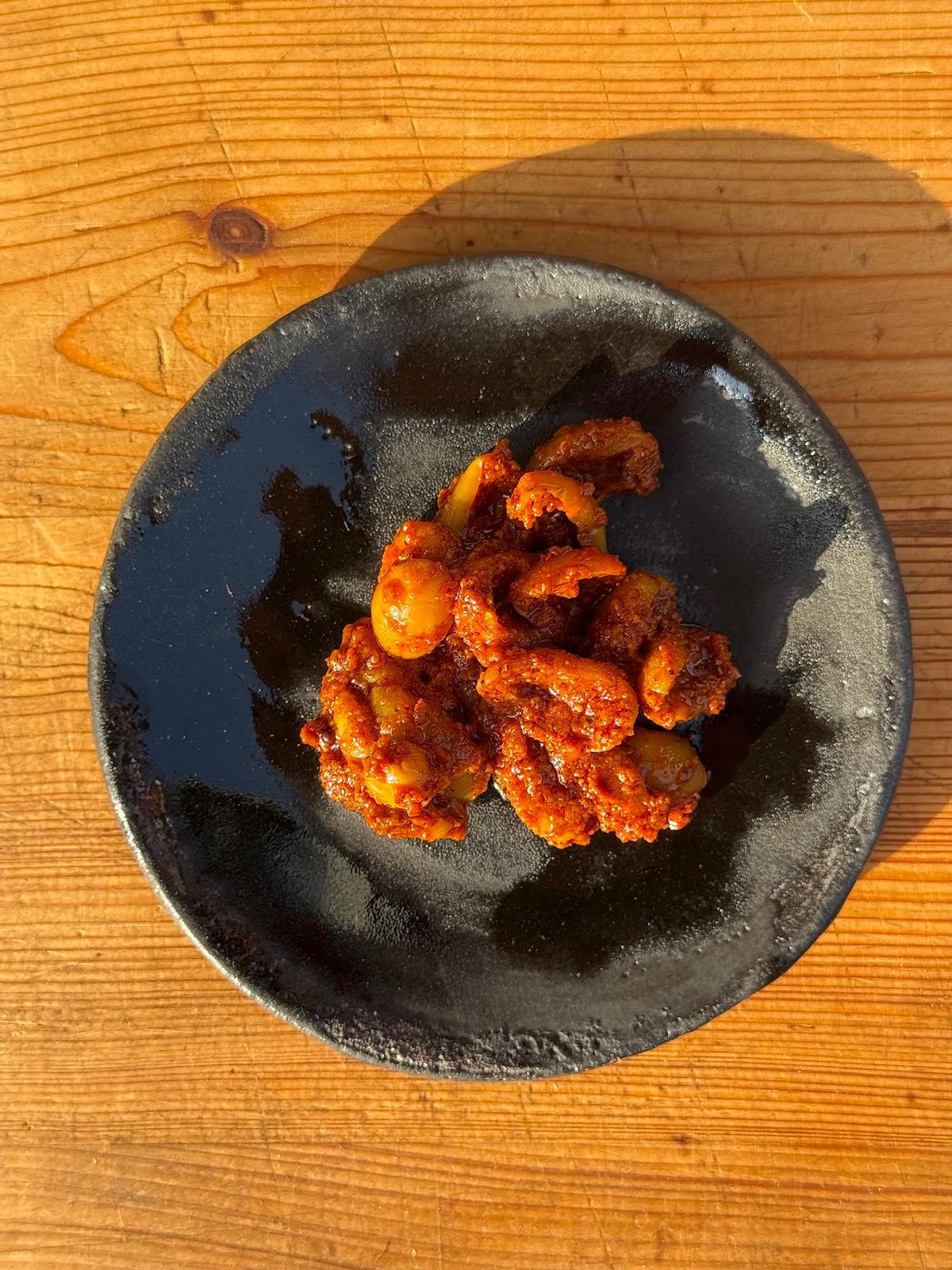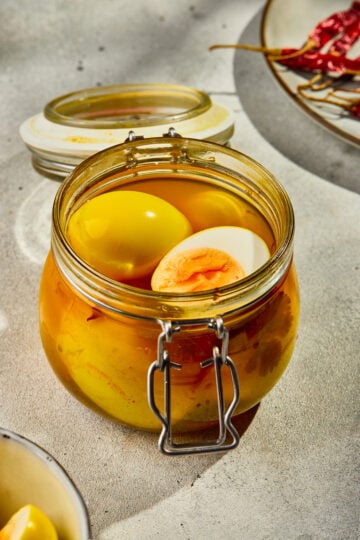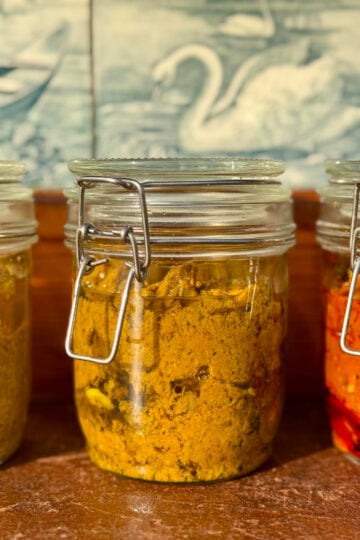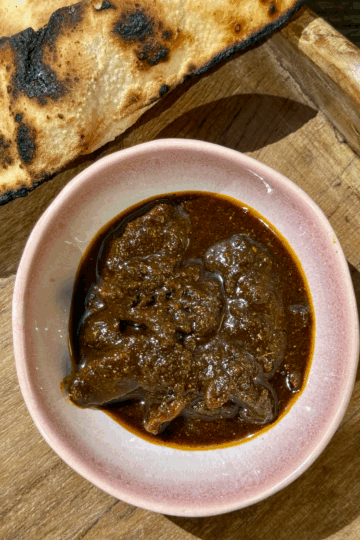
Karonda, also called vakkaya in Telugu, is a small, sharp-tasting fruit native to India. It looks like a little berry or plum, but its flavor is closer to a lemony cranberry — sour, slightly bitter, and full of natural tartness. In many parts of North and Central India, karonda grows on hardy, thorny shrubs and ripens from pale green to deep pink and purple. While the ripe fruit has a gentle sweetness, the unripe green stage is what cooks treasure for pickles and pachadi.
Because it’s already tangy on its own, karonda doesn’t need extra vinegar or a lot of lemon juice. Its natural acidity brings brightness to spices and oil, making it perfect for pickling in summer and monsoon months when the fruit is in season. You’ll find karonda pickles in traditional home kitchens in states like Uttar Pradesh, Rajasthan, Maharashtra and Telangana, often served with roti, dal-rice, poha or stuffed parathas.
This homemade version stays true to those flavors — bold, sour, a little fiery and completely plant-based. It’s naturally vegan and gluten-free, and like most Indian pickles, it only gets better as it rests, letting the spices settle into the fruit and the oil develop a mellow warmth.
Why You’ll Love This Karonda Indian Pickle
- Naturally tangy and spicy flavor
- Vegan and gluten-free
- Easy to make with simple ingredients
- A traditional seasonal favorite in South India

Karonda Pickle
Ingredients
Main
- 2 cups raw karonda vakkaya, deseeded and halved
- ½ teaspoon turmeric powder
- 1 teaspoon red chili powder adjust to taste
- 1 teaspoon salt or to taste
- ½ cup sesame oil or sunflower oil for a lighter flavor
Spice Mix
- 1 teaspoon mustard seeds
- 1 teaspoon fenugreek seeds
- 1 tablespoon chana dal
- 1 tablespoon urad dal
- Pinch of asafoetida hing
Instructions
- Wash and deseed the karonda, then cut them in halves or quarters. Pat dry completely.
- Heat sesame oil in a pan until just hot, then cool slightly.
- In the same oil, add mustard seeds, fenugreek seeds, chana dal, urad dal, and curry leaves if using. Fry until golden and aromatic.
- Stir in asafoetida, turmeric, and chili powder. Remove from heat.
- Add the karonda and salt, mixing well to coat with the spiced oil.
- Transfer to a clean, dry glass jar. Press down so the fruit is submerged in oil.
- Let it rest for at least 24 hours before serving for flavors to develop.
Notes
- Sesame oil gives a more traditional southern flavor, while sunflower oil is lighter.
- For a milder version, reduce the amount of red chili powder.
- Keeps up to 3 weeks at room temperature if fully covered with oil, or 2 months in the fridge.
- Add a spoon of jaggery for a sweet-sour balance.
- Mix in roasted garlic for extra depth.
- Blend the mixture into a smoother paste for a chutney-style spread.
Nutrition
Frequently Asked Questions
Can I use ripe karonda instead of raw?
Ripe karonda is sweeter and softer, so it won’t give the same tang. Stick with raw green karonda for authentic pickle flavor.
Can I use dried karonda instead of fresh?
Yes, you can make pickle with dried karonda, but the flavor and texture will be different. Dried karonda has a concentrated sourness and chewier bite compared to the juicy tartness of fresh fruit. If using dried, soak them in warm water for 30 minutes to soften before pickling, and increase the oil slightly to keep the pickle moist.
Do I need to refrigerate this pickle?
If covered completely in oil, it keeps well at room temperature for a few weeks. For longer storage, keep in the fridge.
Can I freeze karonda Indian pickle?
Freezing isn’t recommended as it changes the texture of the fruit.
What can I eat this with?
It pairs beautifully with plain rice and dal, roti, curd rice, or even as a tangy side to grilled dishes.
- Region: North & Central India (also used in Telangana kitchens)
- Main ingredient: Unripe karonda (vakkaya)
- Flavor: Tart, slightly bitter, spicy and bright
- Key spices: Mustard, fenugreek, chili, turmeric, asafoetida
- Oil: Sesame for traditional flavor; sunflower for lighter taste
- Texture: Firm, juicy, slightly crunchy
- Best with: Rice & ghee, roti, dal-rice, curd rice, stuffed parathas
- Storage: Airtight glass jar, fruit submerged in oil
- Shelf life: ~3 weeks room temp / ~2 months refrigerated
- Diet: Naturally vegan and gluten-free
Troubleshooting
Pickle tastes too bitter
Fenugreek may have roasted too long. Toast until just fragrant and light golden. If bitterness remains, mix in a tiny pinch of jaggery to balance.
Fruit turned soft
Karonda had moisture left or was very ripe. Always pat dry well and use firm, unripe fruit for the best crunch.
Oil separated on top
Normal. The oil acts as a natural preservative. Stir before serving — don’t remove it.
Too salty or too spicy
Add a little warm oil to mellow the flavor. Letting the pickle rest longer also softens the heat and saltiness.
Pickle turned cloudy or spoiled
Usually due to moisture or using a wet spoon. Always keep fruit submerged in oil, store in a clean glass jar and use only a dry spoon.
Too sour
Karonda batches vary in sourness. A touch of jaggery or a sprinkle of chili powder can balance it.
Bringing bold, tangy flavor to even the simplest meal
This vakkaya pachadi is one of those recipes that shows how simple ingredients can turn into something bold and unforgettable. Tangy, spicy, and deeply satisfying, it’s a jar of flavor that makes any meal more exciting.
If you give this karonda Indian pickle a try, drop a comment below with your thoughts. And if you share it on Instagram, tag me — I’d love to see how you enjoy it!







Have a question or something to share? Leave a comment below!